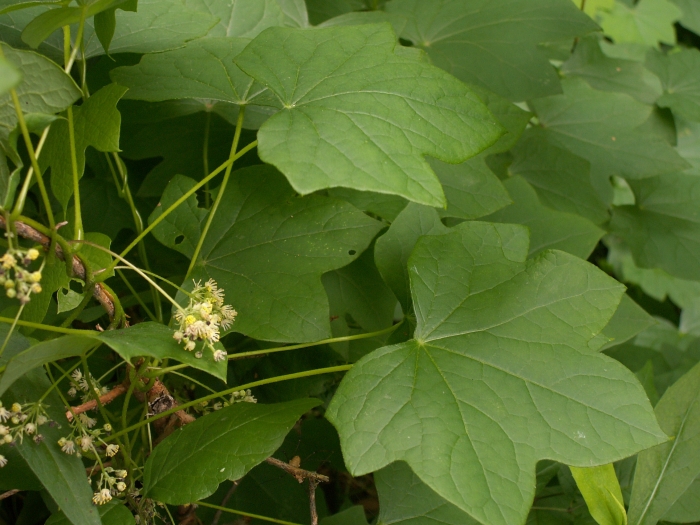Common Moonseed
(Menispermum canadense)
Common Moonseed (Menispermum canadense)
/
/

Cbaile19
CC0
Image By:
Cbaile19
Recorded By:
Copyright:
CC0
Copyright Notice:
Photo by: Cbaile19 | License Type: CC0 | License URL: http://creativecommons.org/publicdomain/zero/1.0/deed.en | Uploader: Cbaile19 | Publisher: Wikimedia Commons | Title: Menispermum_canadense,_2015-06-02,_Frick_Park,_02.jpg | Notes: {{BotMoveToCommons|en.wikipedia}} {{Information |Description={{en|Photo taken by me of the Baginton Oak tree in late July 2006 one evening in [[:en:Baginton]], Warwickshire. [[:en:Category:Individual oak trees]]}} |Source=Transferred from [h




















































Estimated Native Range
Summary
Menispermum canadense, commonly known as Common Moonseed, is a deciduous perennial vine native to rich bottomland forests, moist woodland areas, and stream banks across Central and Eastern USA, as well as Manitoba and Northeastern Mexico. It can grow up to 20 feet (6 meters) tall, twining and climbing with the help of its thin, woody stems. The leaves are broad and heart-shaped, providing a lush backdrop for the small, inconspicuous white or greenish-yellow flowers that bloom in June and July. The flowers give way to clusters of purple-black berries, each about 0.4–0.6 inches (1–1.5 cm) in diameter, ripening between September and October. The crescent-shaped seed within the berry is the origin of its common name. While the vine’s foliage can be mistaken for that of grapes, its fruit is toxic and should not be consumed.
Common Moonseed is valued for its ability to cover unsightly structures and provide quick shade due to its vigorous growth habit. It is often used to cover trellises, arbors, and fences in naturalized or woodland garden settings. This vine prefers a location with full sun to part shade and requires medium amounts of water. It thrives in a variety of soil types, provided they have good drainage. Gardeners should be aware that the rhizomatous roots can lead to the spread of this vine, forming colonies that may need to be managed to prevent unwanted naturalization. Additionally, care should be taken to avoid confusion with edible grape species due to the vine’s potentially poisonous fruit.CC BY-SA 4.0
Common Moonseed is valued for its ability to cover unsightly structures and provide quick shade due to its vigorous growth habit. It is often used to cover trellises, arbors, and fences in naturalized or woodland garden settings. This vine prefers a location with full sun to part shade and requires medium amounts of water. It thrives in a variety of soil types, provided they have good drainage. Gardeners should be aware that the rhizomatous roots can lead to the spread of this vine, forming colonies that may need to be managed to prevent unwanted naturalization. Additionally, care should be taken to avoid confusion with edible grape species due to the vine’s potentially poisonous fruit.CC BY-SA 4.0
Plant Description
- Plant Type: Vine
- Height: 8-20 feet
- Width: 3-6 feet
- Growth Rate: Rapid
- Flower Color: N/A
- Flowering Season: Spring, Summer
- Leaf Retention: Deciduous
Growth Requirements
- Sun: Full Sun, Part Shade
- Water: Medium
- Drainage: Slow, Medium, Fast
Common Uses
Bird Garden
Natural Habitat
Rich bottomland forests, moist woodland areas, and stream banks
Other Names
Common Names: Yellow Parilla, Moonseed, Canadian Moonseed, Canada Moonseed, Moonseed Vine, Ménisperme Du Canada, Amerikansk Månfröranka
Scientific Names: , Menispermum canadense, Menispermum mexicanum, Menispermum canadense var. lobatum, Cissampelos smilacina, Menispermum angulatum, Menispermum canadense var. mexicanum, Menispermum dahuricum var. mexicanum, Menispermum dauricum var. mexicanum, Menispermum smilacinum
GBIF Accepted Name: Menispermum canadense L.